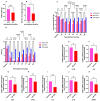iNOS Mediates High-Fat Diet-Associated Aggravation of Complete Freund's Adjuvant-Induced Inflammatory Pain
- PMID: 40508229
- PMCID: PMC12156260
- DOI: 10.3390/ijms26115422
iNOS Mediates High-Fat Diet-Associated Aggravation of Complete Freund's Adjuvant-Induced Inflammatory Pain
Abstract
Chronic inflammatory pain (IP) remains a therapeutic challenge under the worldwide prevalence of the high-fat dietary lifestyle. This study aimed at identifying mediators of the IP augmented by short-term high-fat diet (HFD). IP was induced on C57BL/6J mice by unilateral, intra-plantar, injection of Complete Freund's Adjuvant (CFA). Von Frey test for mechanical hyperalgesia and Hargreaves' test for thermal hyperalgesia were performed at pre-injection baseline and post-injection 6th h. and days 1/3/5/7/10/14. Ad libitum HFD feeding started 2 weeks pre-injection in assigned groups. Body weight and random blood glucose levels were measured. RT-qPCR and ELISA helped quantify expression levels of the selected candidate genes at manipulated hind-paws. After CFA injection, at 1400 W, a highly selective inducible nitric oxide synthase (iNOS) inhibitor was administered regularly to elicit differences in CFA-induced pain behaviors and gene expression in HFD-fed mice. Results showed that HFD-fed mice were heavier (p < 0.001) and relatively hyperglycemic (p = 0.013) at baseline. HFD aggravated CFA-induced mechanical and thermal pain (mechanical: p = 0.0004, thermal: p = 0.003), showing prolonged hyperalgesic durations and reduced pain thresholds at multiple timepoints. HFD-influenced paws showed accentuated overexpression of pro-inflammatory cytokines and iNOS (RT-qPCR for IL-1β: p = 0.015, IL-6: p = 0.019, TNF: p = 0.04; ELISA for iNOS: p = 0.011). At 1400 W, exertion of analgesic effects (mechanical: p < 0.0001, thermal: p < 0.0001) but pro-inflammatory (RT-qPCR for IL-1β: p = 0.004, IL-6: p = 0.03, TNF: p = 0.04) were exerted on the inflamed paw on day 5 post-injection. In conclusion, short-term HFD aggravated CFA-induced inflammatory pain. Pharmacological inhibition of iNOS attenuated the CFA-induced pain in HFD-fed mice. Future research might uncover signaling pathways mediating such effects, potentially benefiting obese patients with chronic IP.
Keywords: iNOS; inflammatory pain; obesity; short-term high-fat diet.
Conflict of interest statement
The authors declare no conflicts of interest. The funders had no role in the design of the study; in the collection, analyses, or interpretation of data; in the writing of the manuscript; or in the decision to publish the results.
Figures






Similar articles
-
Nitric oxide synthase modulates CFA-induced thermal hyperalgesia through cytokine regulation in mice.Mol Pain. 2010 Mar 2;6:13. doi: 10.1186/1744-8069-6-13. Mol Pain. 2010. PMID: 20193086 Free PMC article.
-
[The effect of berberine on ameliorating chronic inflammatory pain and depression].Zhonghua Yi Xue Za Zhi. 2018 Apr 10;98(14):1103-1108. doi: 10.3760/cma.j.issn.0376-2491.2018.14.011. Zhonghua Yi Xue Za Zhi. 2018. PMID: 29690724 Chinese.
-
Differences in inflammatory pain in nNOS-, iNOS- and eNOS-deficient mice.Eur J Pain. 2007 Oct;11(7):810-8. doi: 10.1016/j.ejpain.2006.12.008. Epub 2007 Mar 28. Eur J Pain. 2007. PMID: 17395508
-
AMPK activation mitigates inflammatory pain by modulating STAT3 phosphorylation in inflamed tissue macrophages of adult male mice.Mol Pain. 2025 Jan-Dec;21:17448069251321339. doi: 10.1177/17448069251321339. Mol Pain. 2025. PMID: 39921559 Free PMC article.
-
Peripheral antinociceptive effects of mu- and delta-opioid receptor agonists in NOS2 and NOS1 knockout mice during chronic inflammatory pain.Eur J Pharmacol. 2009 Jan 5;602(1):41-9. doi: 10.1016/j.ejphar.2008.11.019. Epub 2008 Nov 18. Eur J Pharmacol. 2009. PMID: 19041302
References
-
- Prescott S.A., Ratté S. Chapter 23—Somatosensation and Pain. In: Conn P.M., editor. Conn’s Translational Neuroscience. Academic Press; San Diego, CA, USA: 2017. pp. 517–539.
-
- DeMarco G.J., Pascoe P.J. Chapter 1—Anatomy, Physiology, and Effects of Pain. In: Fish R.E., Brown M.J., Danneman P.J., Karas A.Z., editors. Anesthesia and Analgesia in Laboratory Animals. 2nd ed. Academic Press; San Diego, CA, USA: 2008. pp. 3–25.
-
- Hernanz A., De Miguel E., Romera N., Perez-Ayala C., Gijon J., Arnalich F. Calcitonin gene-related peptide II, substance P and vasoactive intestinal peptide in plasma and synovial fluid from patients with inflammatory joint disease. Br. J. Rheumatol. 1993;32:31–35. doi: 10.1093/rheumatology/32.1.31. - DOI - PubMed
MeSH terms
Substances
Grants and funding
LinkOut - more resources
Full Text Sources
Medical

